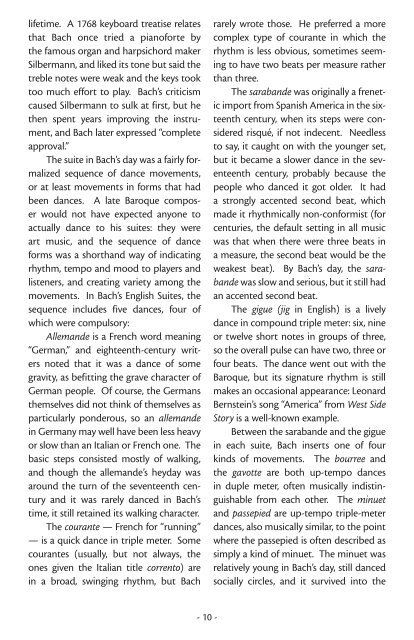You also want an ePaper? Increase the reach of your titles
YUMPU automatically turns print PDFs into web optimized ePapers that Google loves.
lifetime. A 1768 keyboard treatise relates<br />
that Bach once tried a pianoforte by<br />
the famous organ and harpsichord maker<br />
Silbermann, and liked its tone but said the<br />
treble notes were weak and the keys took<br />
too much effort to play. Bach’s criticism<br />
caused Silbermann to sulk at first, but he<br />
then spent years improving the instrument,<br />
and Bach later expressed “complete<br />
approval.”<br />
The suite in Bach’s day was a fairly formalized<br />
sequence of dance movements,<br />
or at least movements in forms that had<br />
been dances. A late Baroque composer<br />
would not have expected anyone to<br />
actually dance to his suites: they were<br />
art music, and the sequence of dance<br />
forms was a shorthand way of indicating<br />
rhythm, tempo and mood to players and<br />
listeners, and creating variety among the<br />
movements. In Bach’s English Suites, the<br />
sequence includes five dances, four of<br />
which were compulsory:<br />
Allemande is a French word meaning<br />
“German,” and eighteenth-century writers<br />
noted that it was a dance of some<br />
gravity, as befitting the grave character of<br />
German people. Of course, the Germans<br />
themselves did not think of themselves as<br />
particularly ponderous, so an allemande<br />
in Germany may well have been less heavy<br />
or slow than an Italian or French one. The<br />
basic steps consisted mostly of walking,<br />
and though the allemande’s heyday was<br />
around the turn of the seventeenth century<br />
and it was rarely danced in Bach’s<br />
time, it still retained its walking character.<br />
The courante — French for “running”<br />
— is a quick dance in triple meter. Some<br />
courantes (usually, but not always, the<br />
ones given the Italian title corrento) are<br />
in a broad, swinging rhythm, but Bach<br />
- 10 -<br />
rarely wrote those. He preferred a more<br />
complex type of courante in which the<br />
rhythm is less obvious, sometimes seeming<br />
to have two beats per measure rather<br />
than three.<br />
The sarabande was originally a frenetic<br />
import from Spanish America in the sixteenth<br />
century, when its steps were considered<br />
risqué, if not indecent. Needless<br />
to say, it caught on with the younger set,<br />
but it became a slower dance in the seventeenth<br />
century, probably because the<br />
people who danced it got older. It had<br />
a strongly accented second beat, which<br />
made it rhythmically non-conformist (for<br />
centuries, the default setting in all music<br />
was that when there were three beats in<br />
a measure, the second beat would be the<br />
weakest beat). By Bach’s day, the sarabande<br />
was slow and serious, but it still had<br />
an accented second beat.<br />
The gigue (jig in English) is a lively<br />
dance in compound triple meter: six, nine<br />
or twelve short notes in groups of three,<br />
so the overall pulse can have two, three or<br />
four beats. The dance went out with the<br />
Baroque, but its signature rhythm is still<br />
makes an occasional appearance: Leonard<br />
Bernstein’s song “America” from West Side<br />
Story is a well-known example.<br />
Between the sarabande and the gigue<br />
in each suite, Bach inserts one of four<br />
kinds of movements. The bourree and<br />
the gavotte are both up-tempo dances<br />
in duple meter, often musically indistinguishable<br />
from each other. The minuet<br />
and passepied are up-tempo triple-meter<br />
dances, also musically similar, to the point<br />
where the passepied is often described as<br />
simply a kind of minuet. The minuet was<br />
relatively young in Bach’s day, still danced<br />
socially circles, and it survived into the


